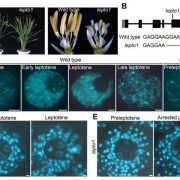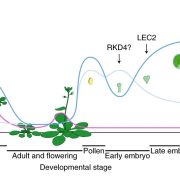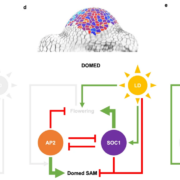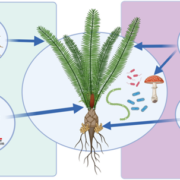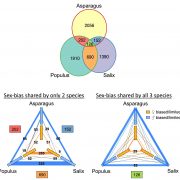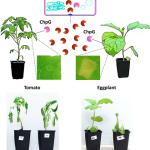ROS homeostasis mediated by MPK4 and SUMM2 determines synergid cell death (Nature Comms)
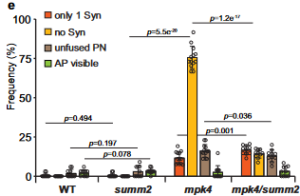 Female gametophytes (FG) of angiosperms contain eight nuclei and seven cells, distributed in a defined manner. In the micropylar end of the FG there are two synergid cells and the haploid egg, while in the central cell there are two polar nuclei. The synergid cells are responsible for attracting the pollen tube (PT). However, only one of the synergid cells will be the one that is receptive to the PT, at which point the receptive synergid instantly undergoes programmed cell death (PCD), whereas the other synergid cell persists. Mitogen-activated protein kinase (MPK) cascades are vital for plant defense; indeed, MPK4 is a negative regulator of plant immunity. The MPK4 downstream cascade is mediated by SUPPRESSOR OF mkk1 mkk2 (SUMM2) which regulates the phosphorylation of CALMODULIN-BINDING RECEPTOR LIKE KINASE 3 (CRCK3/SUMM3). In plant defense, if MPK4 is inhibited (i.e., due to a pathogenic effector), the phosphorylation of CRCK3 decreases, leading to PCD and autoimmunity. In this work, Völz et al. described the role of MPK4 in synergid preservation via the inactivation of SUMM2-mediated ROS production and subsequent cell death. The authors described that the mpk4 Arabidopsis mutant line suffers premature synergid cell death and ROS accumulation, along with an inability to reproduce. In addition, they demonstrate the localization of the MPK4 protein in FG and ovule tissue, and that by disrupting SUMM2, synergid maintenance is restored in mpk4. In conclusion, this work shows how MPK4 governs PCD of synergid cells by repressing SUMM2. (Summary by Eva Maria Gomez Alvarez, @eva_ga96). Nature Comms. 10.1038/s41467-022-29373-7
Female gametophytes (FG) of angiosperms contain eight nuclei and seven cells, distributed in a defined manner. In the micropylar end of the FG there are two synergid cells and the haploid egg, while in the central cell there are two polar nuclei. The synergid cells are responsible for attracting the pollen tube (PT). However, only one of the synergid cells will be the one that is receptive to the PT, at which point the receptive synergid instantly undergoes programmed cell death (PCD), whereas the other synergid cell persists. Mitogen-activated protein kinase (MPK) cascades are vital for plant defense; indeed, MPK4 is a negative regulator of plant immunity. The MPK4 downstream cascade is mediated by SUPPRESSOR OF mkk1 mkk2 (SUMM2) which regulates the phosphorylation of CALMODULIN-BINDING RECEPTOR LIKE KINASE 3 (CRCK3/SUMM3). In plant defense, if MPK4 is inhibited (i.e., due to a pathogenic effector), the phosphorylation of CRCK3 decreases, leading to PCD and autoimmunity. In this work, Völz et al. described the role of MPK4 in synergid preservation via the inactivation of SUMM2-mediated ROS production and subsequent cell death. The authors described that the mpk4 Arabidopsis mutant line suffers premature synergid cell death and ROS accumulation, along with an inability to reproduce. In addition, they demonstrate the localization of the MPK4 protein in FG and ovule tissue, and that by disrupting SUMM2, synergid maintenance is restored in mpk4. In conclusion, this work shows how MPK4 governs PCD of synergid cells by repressing SUMM2. (Summary by Eva Maria Gomez Alvarez, @eva_ga96). Nature Comms. 10.1038/s41467-022-29373-7


